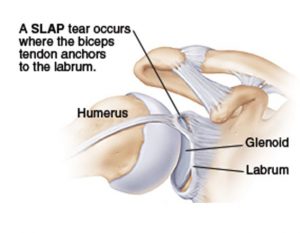A SLAP Lesion tear is an injury to the glenoid labrum. Tearing of the labrum can occur from either acute trauma or repetitive shoulder motion such as in the sports of swimming, baseball and football. Acute trauma may be from dislocation of the shoulder, direct blows to the shoulder, and other accidents of the sort. Tears are classified as either superior or inferior in regards to where the tear is in the glenoid cavity.
A SLAP lesion (superior labrum, anterior to posterior) is a tear where the glenoid labrum meets the tendon of the long head of the biceps muscle. Symptoms include increased pain with overhead activity, popping or grinding, loss of strength, and trouble localizing a specific point of pain. Because a SLAP lesion involves the biceps, pain and weakness may also be felt when performing elbow flexion with resistance.
The glenoid labrum (glenoid ligament) is a fibrocartilaginous structure (not a fibrocartilage as previously thought) rim attached around the margin of the glenoid cavity in the shoulder blade. The shoulder joint is considered a ball and socket joint. However, in bony terms the ‘socket’ (the glenoid fossa of the scapula) is quite shallow and small, covering at most only a third of the ‘ball’ (the head of the humerus). The socket is deepened by the glenoid labrum.


